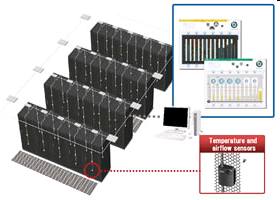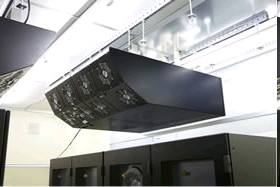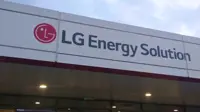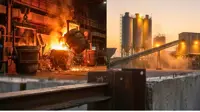Fujitsu, Fuji Electric develop eco-friendly data centre technologies
29 Sep 2009
Fujitsu and Fuji Electric Systems Co Ltd today said they have jointly developed technologies for designing eco-friendly datacentres
The technologies include a datacentre operation management system with energy consumption visualisation technology, as well as a spot air conditioning system which prevents hot spots from emerging inside the datacenter (patents pending).
These technologies promise to reduce CO2 emissions by 40 per centre for IT facilities, including buildings, machine rooms, power supplies and air conditioners, which collectively account for over half of datacentre energy consumption.
The two companies plan to employ these technologies as the basis for an eco-friendly datacentre solutions business. Fujitsu Limited is currently applying these technologies at the new wing of its Tatebayashi System Centre facility, in Tatebayashi, Gunma Prefecture, due to open in November 2009.
The technologies will be exhibited at the Fujitsu booth at CEATEC Japan 2009 from 6-10 October at Makuhari Messe convention center outside Tokyo.
About the Technologies
1. Energy-saving datacentre operations management system (Figure 1)
Fujitsu and Fuji Electric Systems have developed technology to visualise energy consumption, from extra high voltage power supplies to server racks, as well as the temperature and air conditioning conditions of a datacenter. Based on this data, the system can enhance datacentre energy efficiency and air conditioning control. This system comprises several key technologies, which are explained below.
 |
| Figure 1 : Energy-saving datacentre operations management system |
Environment-monitoring sensor network
The system incorporates an environment-monitoring sensor network featuring compact, energy-efficient temperature and airflow sensors, developed by Fujitsu Laboratories Limited, in combination with Fujitsu's proprietary wired ad-hoc networking technology. This makes possible a self-configuring network that requires no special design or configuration, which keeps both deployment and operating costs low while allowing for large-scale, fine-grained environmental sensing with tens of thousands of sensors.
Intelligent power distribution panel
Using newly developed branch breakers with built-in current sensors and high-precision multipoint power-collection equipment, the power distribution panel can monitor in detail each server load. The panel installation areas have been reduced to meet the smaller space requirements of compact server racks.
Power supply optimization and facilities design guidance for datacentre expansion
When expanding IT resources, the system will automatically calculate the most efficient method to run electric wiring from the power distribution panel and breakers, where to install equipment, how to balance three-phase power, and what the air-conditioning requirements will be. This enables optimized cable routing and layout, helping make full use of power distribution panel, uninterruptable power supply systems, and air-conditioning equipment capacity for more efficient facility utilisation.
Rack-mounted step down transformer boxes
The management system utilizes a newly developed compact rack-mounted (2U) step down transformer (capacity: 2 kVA, input: 200 V, output: 100 V) for more efficient cabling designs.
 |
| Figure 2 : Spot air conditioning system |
2. Spot air conditioning system (Figure 2)
The spot air conditioning system was developed as a way to eliminate hot spots within a datacenter. The air conditioning system, which uses the headroom above each server rack, employs Fuji Electric Systems technology used in refrigerated showcases for compact, efficient cooling. The system monitors the utilization of IT hardware and operates at an optimal balance of spot and systemic air conditioning to reduce the cooling system's energy demands by roughly 25% over previous systems.
3. Solar cells mounted to vertical noise baffles
Solar cells have been mounted on vertical noise baffles, something that was difficult to accomplish in the past. This takes advantage of lightweight film substrate solar cells from Fuji Electric Systems, and when used in combination with newly developed high-efficiency power conditioners, significant power savings can be achieved.
In addition to these jointly developed technologies, the new wing of the Tatebayashi System Center will benefit from a facility cooling design that uses outside air, common-area heating utilizing exhaust heat, and thermal flow simulations, all to conserve energy.
The two companies are each offering eco-friendly datacentre design solutions. Fujitsu is offering its Green Infrastructure Solution, and Fuji Electric Systems is offering Green IDC. Both companies expect that these technologies will be able to rapidly reduce the power consumption, electrical costs, and environmental footprints of the IT facilities at datacenters, and contribute to a reduced environmental footprint for society as a whole.






















